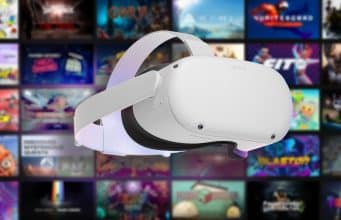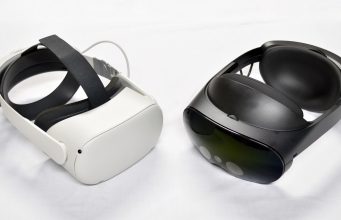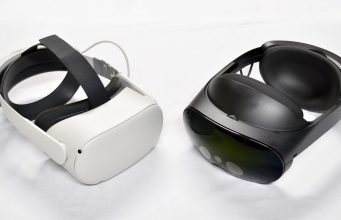The end of 2022 marks more than a decade since the Oculus Kickstarter sparked the modern era of VR. While the space has undoubtedly grown tremendously since then, 2022 felt largely like a plateau year, with Meta standing unchallenged as the dominant player in the space—while progressing disjointedly in too many directions at once. But with new headsets, promising new content, and a looming heavyweight positioned to challenge Meta all on the horizon, 2023 could big a much bigger year for the VR space.
The 2022 Plateau
2022 wasn’t a bad year for VR by any means, but for the most part the status quo remained unchanged.
There’s no doubt that Meta has been the central pillar of the VR space in 2022, having pivoted its attention in a very public way by renaming the entire company to Meta just before the year began. The company’s Quest 2 headset has retained its position as the most popular headset on the market, even becoming the most-used headset among PC VR players, despite Meta having all but abandoned PC VR as a platform.
Despite its dominance (or perhaps because of it), Meta has continued to make very good hardware while struggling deeply with its software. Though Quest 2 is certainly more capable than similar products, the user experience is disjointed and unrefined. The Quest Pro only continued this trend; the high-end headset brings a range of impressive improvements to the hardware along with new sensing capabilities, but its new features are significantly hampered by an undercooked software offering.
Regardless of various missteps, Meta is undoubtedly doing the most to keep VR afloat right now. Quest 2 is an affordable headset that’s created a large enough market of users that developers are finding growing success on the platform. In 2022 that’s meant that many developers have begun or continued to treat Quest 2 as their highest priority platform. To that end, we saw many ports of existing VR games coming to Quest 2, and most new releases being either Quest 2 exclusive, or on Quest 2 and some other platforms.
Unfortunately Meta’s dominance has meant that much of the air in the room as been sucked away from other parts of the VR space that were once key pillars.
Despite the release of new and updated enthusiast PC VR headsets, the platform has stagnated due to the content focus shifting away from PC VR. Many of the games released this year on PC VR were designed first and foremost for Quest 2, which means many lacked the scale and polish that resonates with enthusiast PC VR users.
Valve’s seeming disinterest in VR ever since the release of Half-Life: Alyx back in 2020 hasn’t helped either. The company continues to sell its 2019 headset for the same price that it was charging on day one, with no official confirmation that it has plans to do anything major in the VR space (hardware or software) in the near future. Sony’s PSVR1, meanwhile, has largely lost any remaining relevance since the announcement of the upcoming PSVR 2.
On the Horizon for 2023
But there’s lots of interesting things on the horizon for VR in 2023. Crucially we may see some real competition for Meta from several different angles, which is sorely needed to keep the company (and the industry at large) on a steady course toward making VR a more valuable platform in order to increase mainstream viability.
First Up
The biggest near-term event for the VR industry in 2023 will be the launch of PSVR 2 in February. Although Sony has technically continued selling its original PSVR headset over the years, it’s been on the market for more than six years now—and gained ‘last-gen’ status well before that.
Given all that time between—and that the company isn’t bringing its exclusive VR content forward to the new headset—the upcoming launch of PSVR 2 feels like a re-entrance into the VR market for Sony rather than a continuation. But now that the company has made the commitment, they’ll likely put strong support behind the headset for at least a few years.
Importantly, as a console maker, Sony knows well that ‘content is king’, and we can expect to see a new slate of quality VR content funded by the company, some of which could make it onto other headsets. Sony’s original PSVR is still home to some of the best exclusive VR games in the industry, made by its own first-party studios; at a minimum it would be nice to see those top titles updated and improved for PSVR 2, and better yet it would be great to see Sony setting its first-party studios to the task of creating high quality VR content once again.
But PSVR 2 only represents pseudo-competition for Meta, since the headset only appeals to those that already own a PS5 (or who are willing to buy a PS5 just to get the headset).
Real Competition for Meta?
On the other hand, some real competition from the likes of Pico and HTC may be on the way.
On the high-end, HTC’s newly announced Vive XR Elite is clearly positioned to compete with Meta’s Quest Pro. With most of the same essential features, but a lower price point ($1,100 vs. $1,500), the Vive XR Elite at least looks at face value like an alternative choice for those looking for a more compact VR headset with improved passthrough AR capabilities.
And on the low-end, Pico’s recently launched Neo 4 is the first such headset that is truly competing on price with Quest 2. Priced at €20 or €50 less than Quest 2 (depending upon storage capacity), looks like a real alternative. Granted, the company has yet to formally bring its headset to the United States—Meta’s home turf.
But… both Vive XR Elite and Pico Neo 4 share a common problem, and that’s content.
A Big Moment for Content Momentum
Regardless of specs and price, unless the content that users want is available on these headsets, they are difficult to consider real options (and thus real competition). As of now, both headsets lack many of the best-selling and most-played killer apps that are available on Meta’s Quest headsets.
But that could finally be changing. Compared to prior alternative standalone headsets, XR Elite and Neo 4 have a much more significant and recognizable body of content than we’ve seen in the past. If more developers recognize the benefit that both they and consumers alike would see from having a more competitive standalone market… perhaps this could be the start of an important sea change in the industry.
The Elephant in the Room
Of course the single biggest elephant in the room has been and will continue to be Apple. It seems that every month we get a new rumor about when the company will enter the market, with the only certainty being that the company is definitely hard at work on something—though no one knows precisely when they will announced it, let alone launch it.
Apple, more than any other company in the world, has the potential to disrupt Meta at its own game by releasing an XR headset with a highly polished user experience… something the social-media-turned-metaverse company (and frankly the VR industry at large) has struggled with.
Make no mistake, Apple’s entrance into the XR space will have wide reaching implications practically overnight—both within the XR space and outside of it.
Look for UX Innovation, Not a Hardware Breakthrough
But nobody should be expecting hardware breakthroughs from Apple. The company is stuck with the same (largely physical) constraints as the rest of the major players in the industry. Whatever device they launch is likely to have similar specs and form-factor to what the latest headsets we see on the market today. More importantly however, Apple is likely to contribute key software design, device interoperability, and overall UX learnings that other companies in XR have consistently struggled with.
While Apple is certainly a threat to the likes of Meta, the company’s entrance into the market is also likely to be a boon for Meta overall; not only will it be a validation of Meta’s early and ambitious bet on the space, but the best XR design concepts revealed from within Apple will be adopted for the betterment of the industry at large. For Meta, Apple’s entrance into the space can’t come soon enough.
Meta Faces the Same Old Struggles
While Quest 2 has been more widely adopted than any other standalone headset, user retention continues to be an issue. Not only due to substandard UX, but also the headset being stuck in an arcade phase where years-old games like Beat Saber, Superhot VR, and Job Simulator continue to be among the most popular games on the platform—seemingly signaling that only a small amount of compelling new content has reached the headset in the years since Quest 2 has launched. Meanwhile, the headset most enthusiastic userbase—core gamers—is underserved, waiting for the sort of large-scale and highly polished content that they expect from the traditional gaming space.
As for Meta’s 2023… outside of the Apple wildcard, the company has confirmed that it’s working on a next-gen consumer headset due out this year, which is very likely to be Quest 3. And while the company has some pretty wild R&D projects in the oven, more likely than not, Quest 3 will adopt core parts of the Quest Pro headset rather than offering some kind of major leap in features or form-factor.
Last But Not Least
As for PC VR, the only thing keeping the platform alive is an enthusiast player base that’s hungry for greater immersion and starved for next-gen VR content. Unfortunately with so much attention focused on standalone VR by platform holders and developers, PC VR in 2023 will be largely stuck with content built for other platforms that happens to spill over.
Between that content, the VR modding scene, smaller-scope projects from enthusiast indie developers, and the occasional release of VR-optional flight or racing sims—PC VR will feel like it’s on life support through 2023.
PC VR is and continues to be the place where users can push immersion to the next level with niche accessories like full-body trackers, racing & cockpit peripherals, haptic vests, and gun stocks. And while some unannounced PC VR headsets may make an appearance in 2023, the drought of next-gen PC VR content means dwindling reasons to upgrade.
– – — – –
What’s your 2023 VR outlook? Let us know in the comments below.






